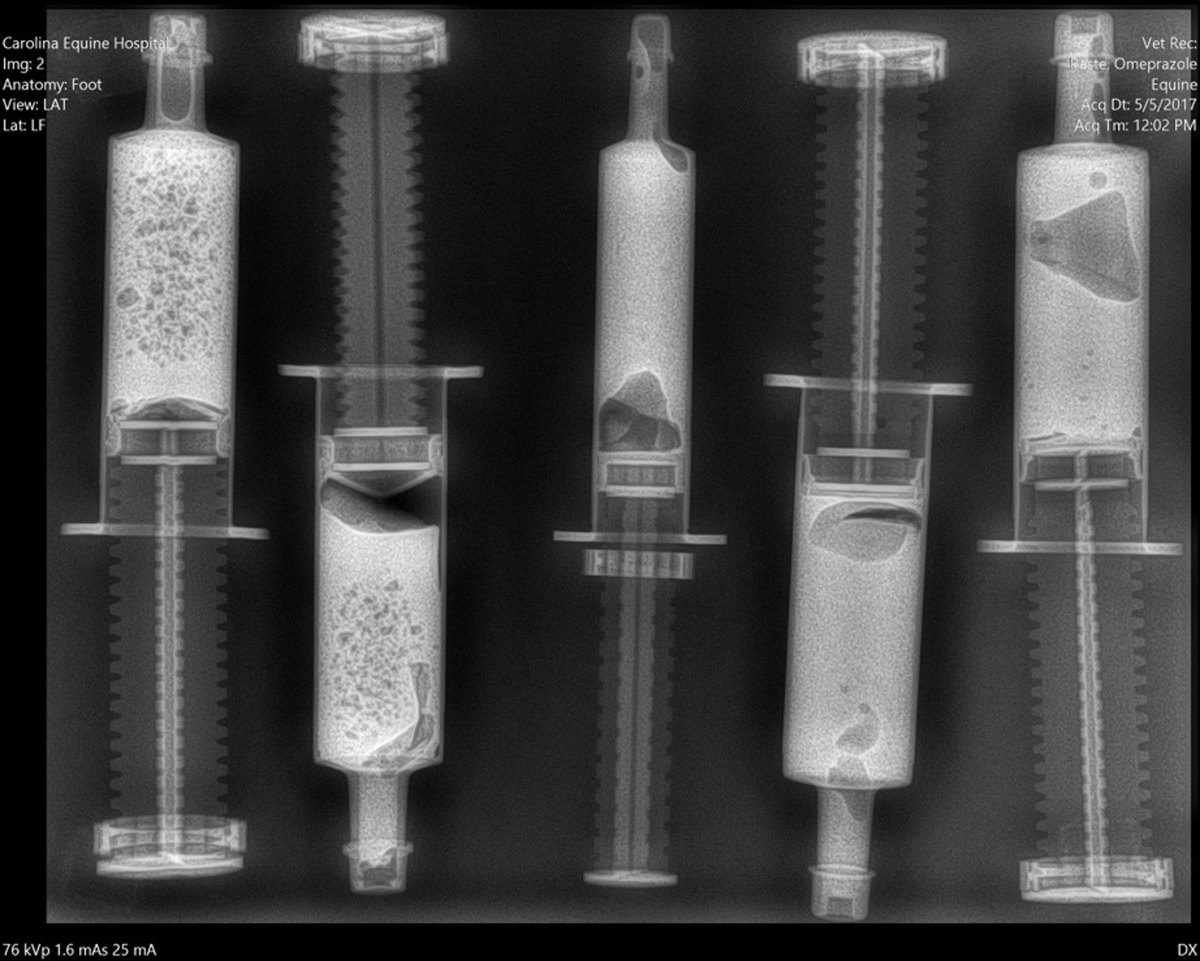
When using compounded products, equine practitioners need to evaluate the integrity of compounding pharmacies as well as the quality and consistency of compounded drugs. Potency, purity and stability of each drug are considered. In addition, a practitioner is well advised to take note of the liability associated with use of each product, particularly if poor consistency or quality of a drug doesn’t yield treatment results. With that in mind, one equine practitioner investigated product quality of a commonly used medication, omeprazole.
What’s in the Tube?
Mark Wallace, DVM, MS, DACVIM, of Carolina Equine Hospital, presented a poster at the 2017 ACVIM meeting about production quality of omeprazole products. Through digital radiographic evaluation, he investigated what is in the tube of compounded or illegally-obtained omeprazole, especially compared to Gastrogard. Commercially available as an anti-ulcer medication from Merial, omeprazole comes in two FDA-approved forms: Gastrogard and Ulcergard.
In all, two tubes each from 13 different products – five different compounded formulations and 8 different illegally produced OTC products – were evaluated and compared to the FDA-approved Gastrogard. The study reported, “Syringe fill, air pocket presence and product consistency were evaluated by the investigator. All compounded and over-the-counter products that were studied had clearly visible incomplete fill and air pockets. Several of the products also showed variability in homogeneity. GASTROGARD Paste syringes had complete fill, no air pockets and were homogenous.”
The visuals provided by the investigative X rays speak for themselves.
When a single dose of paste from a multi-dose syringe was squirted onto a plate, there were major differences in consistency throughout the tube, said Wallace.
This study did not evaluate concentration of milligrams per milliliter or efficacy; it was simply a physical assessment of content volume and homogeneity of the paste in single and multi-dose products.
Wallace said, “Of all the omeprazole products we investigated, every company but one required a veterinary prescription.” This is significant in that practitioners forearmed with knowledge of product quality can help clients make a better informed choice of where to buy this medication. This example proves to be a case of “you may get what you pay for.” While the compounded and illegally produced omeprazole products might cost less than 50% of the FDA-approved medication, purchasing the FDA-approved omeprazole includes product quality assurance.
Efficacy
Another point to consider about omeprazole is its efficacy. Scott Stanley, PhD, a professor in the K.L. Maddy Equine Analytical Chemistry department at the University of California, Davis, reported on compounding issues with omeprazole at AAEP some years ago. Of note is that when the pH of omeprazole falls below 7.8, it rapidly deteriorates. HIs testing of compounded omeprazole products demonstrated not only low pH values, but also dosing inconsistencies. On arrival at the test lab, only 1 of 6 products (17 %) met FDA potency requirements.
Take-Home Message
In the event that you use a compounding facility to provide drugs to your clients, research as much information as possible about a compounding pharmacy, including the following:
- Is the company accredited by the Pharmacy Compounding Accreditation Board (PCAB)?
- Has the pharmacist obtained appropriate training?
- Does the pharmacy have liability insurance?
- What types of materials (pharmaceutical versus chemical or bulk grade) are used in preparation?
- Where were these materials obtained?
AAEP requires PCAB accreditation of compounding pharmacies to meet a minimum standard. The objective is to ensure that your clients are obtaining the most efficacious and consistent products to treat their horse’s medical ailment.
FDA-approved products go through a battery of testing to ensure that each dose of a product is reliably the same, and that the medication is efficacious for the ailment being treated. Considering the many variables that go into production enables practitioners to provide the best care for their equine patients.
Editor’s note: Wallace noted in his poster presentation the following:
CONFLICT OF INTEREST DISCLOSURE: This research study was completed with funds and materials provided by Merial, Inc. (3239 Satellite Boulevard, Bldg. 500, Duluth, Georgia 30096). The author’s affiliation with Merial Inc. is limited to his role in providing research services for this project. The sponsors of this project have played no role in analysis of results and have had no editorial influence over the written text provided here.
You can open or download a PDF of this poster by clicking on the link below.
RADIOGRAPHIC EVALUATION OF COMPOUNDED AND ILLEGAL OVER-THE-COUNTER OMEPRAZOLE PRODUCTS








